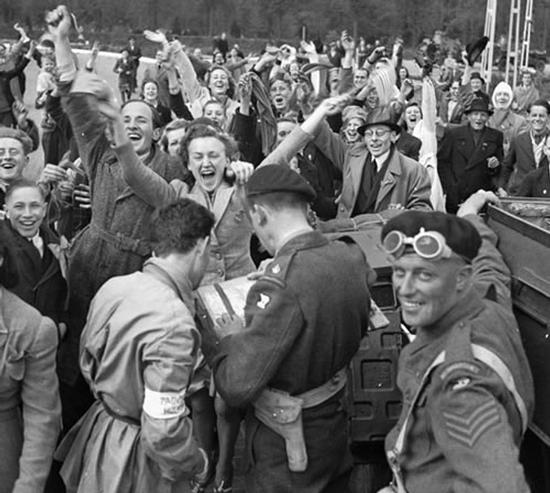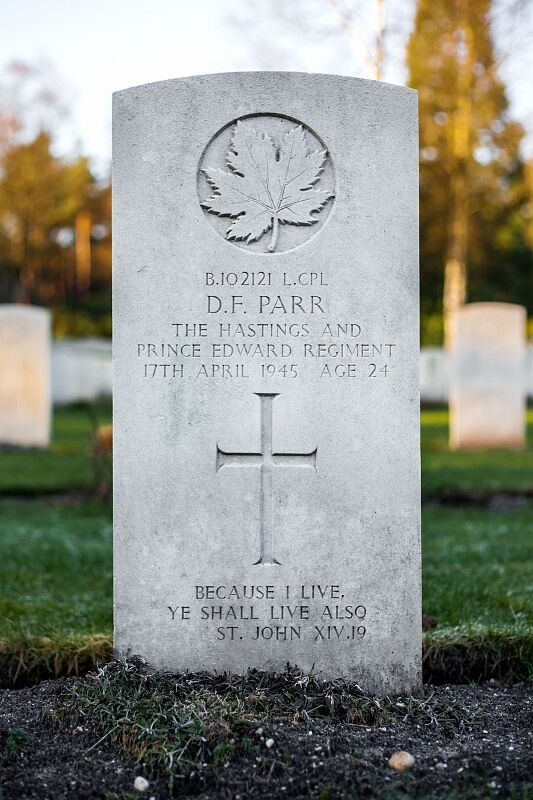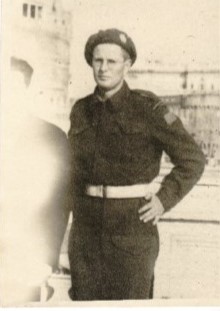This is Part 53, the final instalment in our year-long series, The Monuments Men. It’s been a century since Niagara-on-the-Lake’s iconic clock tower cenotaph was erected. Then, in 1926, the Township of Niagara unveiled its own memorial in Queenston. In recognition of those who fought and died in two world wars and beyond, NOTL historian Ron Dale researched the stories of the people – all men – whose names are engraved on the two cenotaphs. This series of stories documented and remembers the sacrifices of those commemorated on the municipal memorial in Queenston.
Ron Dale
Special to The Lake Report
Donald Francis Parr was a 21-year-old apprentice typesetter working for the Niagara Falls Review when he volunteered to go to war.
He was born on March 9, 1921, son of Harold Benson Parr and Ailene McLean of St. Davids, when young Donald attended school.
Parr enlisted in Hamilton on July 20, 1942, and his training seems to have been geared toward a role in the Royal Canadian Army Service Corps.
For more than a year, until Aug. 19, 1943, he attended the Canadian Army Trades School in Hamilton and then the Canadian Technical College in Newmarket until the end of September.
He was then sent to Aldershot, N.S., for the Infantry Training Course, where he qualified in small arms, machine-guns, mortars and grenades.
His training continued in Canada, with Parr learning to operate military vehicles. Finally, considered trained sufficiently to go to war, he boarded a ship in Halifax and arrived in the U.K. on April 18, 1944, reporting for duty to the Number 4 Canadian Infantry Reinforcement Unit.
He was sent to the Mediterranean theatre of war where the 1st Division of the Canadian Army had fought in Sicily from July 10 to Aug. 6, 1943, and in Italy since Sept. 3. 1943.
Parr disembarked in Italy on May 3, 1944, to join the Hastings and Prince Edward Regiment, known as the “Hasty P’s.”
He reached the regiment on May 16 as its members prepared to attack the Hitler Line, a heavily defended German position. For the next 10 months, the Hasty P’s fought in numerous large-scale battles and minor skirmishes. Casualties were heavy but Parr came through it unscathed.
On March 10, 1945, the Hasty P’s boarded landing ships in Leghorn (Livorno), Italy, and landed the following day in Marseilles, France. The men climbed into a waiting convoy of trucks and headed north to participate in the liberation of Holland.
The men were in good spirits. The Germans were slowly retreating on all fronts.
Iconic Canadian author Farley Mowat, an officer of the Hasty P’s, who wrote about his experiences in “The Regiment,” explained that “the end of the war itself was coming close – closer with each mile the convoy travelled.”
On March 10, the convoy reached Belgium and the regiment rested there. Mowat wrote that “many believed they would not again see battle.” They were wrong.
On April 3, they were ordered to the front to participate in a final campaign to cut off half of the German Army tenaciously defending its positions in Holland.
The regiment’s task was to move from Zutphen across the Ijssel River and advance toward Apeldoorn. On April 12, their attack began, with the regiment ferried across the Ijssel in amphibious Buffalo armoured vehicles.
The men suffered casualties in the advance toward Apeldoorn but continued the assault, resisted by pockets of well-armed German defenders. On the night of April 16 to 17, Apeldoorn was liberated. Canadian soldiers could revel in the party-like atmosphere as the long-suffering citizens of Apeldoorn welcomed their liberators.
There was still more to do. Passing through Apeldoorn, the Hasty P soldiers, riding on tanks, approached the Nieuwmilligen Forest on April 17.
The forest concealed fanatical soldiers of the infamous “SS,” in this case Dutch Nazis, who would fight until the last man and not risk capture by their formerly oppressed Dutch neighbours.
The fight was a fierce one, with German anti-tank artillery, mortars, cannons, machine-guns and rifles taking their toll on the advancing Canadians. Casualties were heavy.
Among those killed in action on April 17, 1945, was Lance-Cpl. Donald Parr, the last man from Niagara-on-the-Lake to be killed in the Second World War.
This was the final action fought by the Hastings and Prince Edward Regiment. Its members were withdrawn from the front on April 23. On May 5, the German forces in Holland surrendered and two days later all German forces in Europe followed suit.
May 8 was declared Victory in Europe (VE) Day. Donald Parr had been killed three weeks before the end of the war in Europe.
He lies buried in the Holten Canadian Military Cemetery in Holland and is commemorated on the Niagara Township War Memorial in Queenston.












